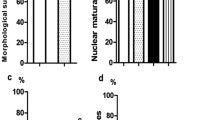Abstract
We have evaluated the morphology of the mouse preimplantation embryos at developmental stages from morula to late blastocyst after two different impacts: microinjection of modified Witten’s medium and osmotic stress in physiological osmolarity (310 mOsM), in 5% glucose (560 mOsM) at high concentration of NaCl (614 mOsM). Results of our research showed that these stresses caused similar changes in embryo morphology: volume was reduced followed by its recovery in culture medium (osmolality was less than a physiological value, 260 mOsM). The ability of embryos to recover the volume and morphology up to the initial level depends on a stage of embryo development and consequently competence of TB cells. In this study it was revealed that a key role in regulation of volume homeostasis after microinjection and after short-time (30–60 min) osmotic stress belongs to TB cells. Both physical effects induce the further embryo development in vitro up to the formation of primary colonies of embryonic and trophoblastic cells. These data could be used to develop the morphological criteria for a prediction of blastocyst-stage embryonic implantation potential.
Similar content being viewed by others
References
A. Nagy, M. Gertsenstein, K. Vintersten, and R. Behringer, in Cold Spring Harbor (Cold Spring Harbor Laboratory Press, N.Y., 2003), pp. 268–271.
T. P. Fleming, B. Sheth, and I. Fesenko, Front Biosci. 6, D1000 (2001).
A. J. Watson and L. C. Barcroft, Front. Biosci. 6, D708 (2001).
L. C. Barcroft, H. Offenberg, P. Thomsen, and A. J. Watson, Develop. Biol. 256, 342 (2003).
Y. Yamanaka, A. Ralston, R. O. Stephenson, and J. Rossant, Dev. Dyn. 235(9), 2301 (2006).
G. M. Kidder, Can. J. Physiol. Pharmacol. 80(2), 110 (2002).
Y. Zhao, P. A. Doroshenko, S. L. Alper, and J. M. Baltz, Dev Biol. 189(1), 148 (1997).
A. Ben-Chetrit, M. Antenos, A. Jurisicova, et al., Mol. Hum. Reprod. 8(8), 758 (2002).
F. Wang, M. Kooistra, M. Lee, et al., Biol. Reprod. 85(4), 702 (2011).
C. L. Steeves, M. A. Hammer, G. B. Walker, et al., Proc. Natl. Acad. Sci. USA 100(24), 13982 (2003).
J. D. Biggers, J. A. Lawitts, and C. P. Lechene, Mol. Reprod. Dev. 34(4), 380 (1993).
M. A. Hammer and J. M. Baltz, Mol. Reprod. Dev. 62(2), 195 (2002).
M. A. Hammer, G. B. Walker, D. Rae, et al., Proc. Natl. Acad. Sci. USA 100(24), 13982 (2003).
K. M. Dawson, J. L. Collins, and J. M. Baltz, Biol. Reprod. 59(2), 225 (1998).
J. M. Baltz and C. Zhou, Mol. Reprod. Dev. 79(12), 821 (2012).
G. Longenecker and A. B. Kulkarni, Curr. Protoc. Cell Biol. 19, 1 (2009).
F. Guerif, M. Lemseffer, M. Blanchard, and D. Royere, J. Assist. Reprod. Genet. 26(8), 443 (2009).
O. P. Berezovskaya, L. M. Mezhevikina, and B. N. Veprintsev, Ontogenez 17(5), 553 (1986).
J. A. Lawitts and J. D. Biggers, Methods Enzymol. 225, 153 (1993).
J. M. Baltz, Methods Mol. Biol. 912, 61 (2012).
T. Hadi, M. A. Hammer, C. Algire, et al., Biol. Reprod. 72(1), 179 (2005).
S. Jansen, T. Esmaeilpour, M. Pantaleon, and P. L. Kaye, Reproduction. 131(3), 469 (2006).
R. Augustin, P. Pocar, A. Navarrete-Santos, et al., Mol. Reprod. Dev. 60(3), 370 (2001).
P. Bermejo-Alvarez, R. M. Roberts, and C. S. Rosenfeld, Mol. Reprod. Dev. 79(5), 329 (2012).
L. A. Frank, M. L. Sutton-McDowall, D. L. Russell, et al., Reprod. Fertil. Dev. 25(8), 1095 (2013).
Author information
Authors and Affiliations
Corresponding author
Additional information
Original Russian Text © E.A. Khramtsova, L.M. Mezhevikina, E.E. Fesenko, 2014, published in Biofizika, 2014, Vol. 59, No. 2, pp. 314–321.
Rights and permissions
About this article
Cite this article
Khramtsova, E.A., Mezhevikina, L.M. & Fesenko, E.E. A role of trophoblastic cells in regulation of mouse blastocyst survival in vitro after microinjection and osmotic stress. BIOPHYSICS 59, 257–263 (2014). https://doi.org/10.1134/S0006350914020134
Received:
Published:
Issue Date:
DOI: https://doi.org/10.1134/S0006350914020134




